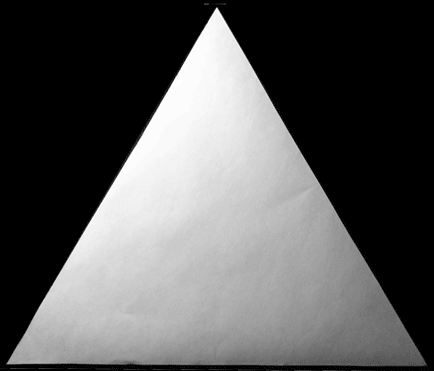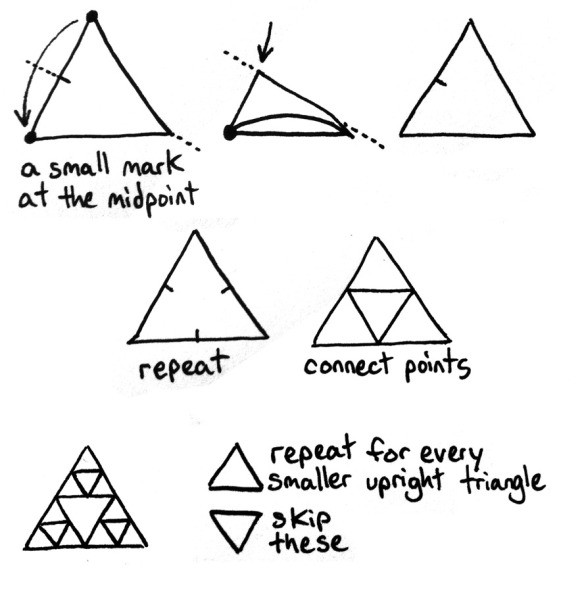Author Archives: robby
golden ratio


this is an origami ruler. you can make one out of scrap paper, so long as it has one long straight edge. the scrap ends left over from cutting a square from a rectangle work perfect. they can be used in two different ways, fractionally, and additively.

when working on any piece, it’s helpful to know where the meridians lie to be aware of and unleash all possible geometrically pleasing ratios. the best fractional ruler is cut to the length of the object you are working on.

put as many folds into the ruler as you can until it gets confusing: fourths/eighths/sixteenths, thirds/sixths, square root of 3 or 2.
for the additive ruler, you begin from one side, and usually end up with left over paper.

holding the paper up to this pentagon in this manner, we can put a crease in the ruler that represents the length of one of the sides.

fold the ruler again, back and forth, so the paper doesn’t bunch. repeat as long as you like.

now we have the perimeter of the pentagon
my favorite game can be folded from any scrap paper, the longer the better.

begin with one small line

duplicate the segment 3 times, as explained earlier

leave the last fold folded, and here’s where our loop begins. start by counting from the last fold, count the creases in reverse order from when they were created. remember not to count the one that is currently folded.

after counting 2 creases back, use the crease as a guide for the large length of paper remaining. fold back along this crease.

keep your new crease, and unfold the old. this is the end of the loop.

begin again- count two creases back, and fold the large sheet using the crease as a guide.

retain your last crease, and unfold the old one.

repeat as long as you still have paper!
this is the fibonacci sequence. 1, 1, 2, 3, 5, 8, 13, 21, 34, 55… each number is the sum ( + ) of its two previous numbers. every fold in our ruler was folded on the crease 2 creases back, an automatic summing machine!
nature has harnessed this sequence to overcome a myriad of hurdles. plants use it to sprout branches no one gets covered and each gets maximum amount of sunlight, and as you can see, our hands use it to allow our fingers to fold into a fist.

each crease you add into this pattern brings you closer to a particular number:
1 to 1 = 1
2 to 1 = 2
3 to 2 = 1.5
5 to 3 = 1.6666
8 to 5 = 1.6
13 to 8 = 1.625
21 to 13 = 1.615
34 to 21 = 1.619
55 to 34 = 1.618
the exact number is never-ending: 1.6180339887498948482…. this proportion is so inherent to nature’s processes we have nearly deified it over the ages. It showed up in ancient Greek architecture, the Renaissance artists employed it heavily, and every mathematician since Pythagoras has marveled over it. today, we have found it makes life better in the most odd circumstances, my favorite story is that bees inhabiting a rectangular hive container constructed with respects to the golden ratio will produce more honey than those in a arbitrarily conceived container. any opportunity to be utilized should be taken. this number, the golden ratio, or φ (pronouced “fee”), 1.618.
equilateral triangles
2π
attention on the space inside of a shape- there exists a balancing point, and for regular polytopes, it is at the exact center.
an exciting property of hexagons: a regular hexagon is comprised of 6 equilateral triangles
these triangles are equilateral because all their sides have the same length. for the hexagon, this means the line going to the center is the same length as one of its edges.
unroll the lines and lay them side by side. since the line going to the center is the same length as ONE of the six sides, you need six more to equal the length of the hexagon’s edge.
this is the only shape with which this works easily. here is a triangle:
five almost makes it, and six is too many:
![]() the precise number needed is 5.2_____
the precise number needed is 5.2_____
 Triangle: 5.2
Triangle: 5.2
Square: 5.66
Pentagon: 5.88
Hexagon: 6
Octagon: 6.12
the number is getting higher and higher,
let’s try a 96 sided figure:
 this looks like a circle. it’s pretty close to a circle. we can unroll this like we did with the other shapes, but the math gets intense. Archimedes computed the answer over 2,000 years ago:
this looks like a circle. it’s pretty close to a circle. we can unroll this like we did with the other shapes, but the math gets intense. Archimedes computed the answer over 2,000 years ago:
96-gon: 6.2837
but this isn’t the final answer either. as the number of sides of the shape increase, the shape converges to a circle, and the closer you get to this particular number, 6.28-something. why did the circle, such a perfect form, have a number hidden in it that is SO difficult to find? over time, people speculated it was the result of a complex fraction: 512/81 (Egypt), or 710/113 (China). but not until the 1700’s did we finally learn for sure: this number goes on forever.
6.28318531…..
one of the most perfect shapes in the universe contains a number inexpressible by any other form. we refer to it as τ or 2π.
Snowflake forming patterns
Snowflakes begin forming as water begins to freeze around a piece of dust or pollen or other particle suspended in a cloud. This particle becomes the seed which holds the blueprint and in a slightly deterministic knows the shape of the snowflake from the very beginning. The variables that shape otherwise are weather conditions like humidity, pressure, electricity, and temperature.
The triangle’s pointiest point is the center of the snowflake. I have drawn cells on my triangle emanating from this point to study the patterns more closely:
snowflakes exhibit 6 fold rotational symmetry, and each of the 6 arms exhibits 2 fold mirror symmetry. 1/12th of the entire shape is all you need to re-create the snowflake.
Wilson Bentley was the first to show us what a snowflake looked like with such detail

superimpose half of one of the six arms onto our triangle
Coloring the squares will describe the pattern in terms of cells
—————-total columns vs columns filled—————-
# 1 2 3 4 5 6 7 8 9 10 11 12 13 14 15 16
# 1 2 3 4 5 6 5 7 7 8 9 6 9 10 8 5
%100 100 100 100 100 100 71 88 77 80 82 50 69 71 53 31
The left side (center of snowflake) is always filled 100% for some number of columns, which builds a hexagon at the center of the snowflake. The bottom line is always filled in by some number, and the vertical extensions decrease by some number as the edge approaches. If the entire piece was filled, the snowflake would be a large hexagon.
Variables that determine the pattern:
(seed shape), temperature, humidity, pressure, electricity
9 Snowflake Photos by Kenneth G. Libbrecht, Caltech
the first thing you might notice is most patterns exhibit a similar direction of growth
 the myriad of the shapes of the growths can be represented as a transformation from a regular hexagon. the lines can move if they remain parallel to themselves, and the angles between them will always be 120 degrees.
the myriad of the shapes of the growths can be represented as a transformation from a regular hexagon. the lines can move if they remain parallel to themselves, and the angles between them will always be 120 degrees.
some growths more represent clumps, and others chutes.
Shapes
There exists a hierarchy with regards to symmetry. Some forms are more perfect than others, and should be offered precedence under few axioms.
– Being three-dimensional creatures, an interaction with other three-dimensional forms is most perceivable.
– Two dimensional and one dimensional shapes are more comprehendible than those in four or five or more dimensions.
– Symmetry is qualitative
3 dimensions:
Despite the overwhelming amout of interdisciplinary study which has taken place on these forms for thousands of years, they are incredibly symmetrical and simple.
When holding one, allow your attention to either flow from the faces to the lines to the points, or the reverse. points are a natural beginning (the 0 dimension) but harder to grasp, two points make a line, and three or more lines make the edges of a face, the most tangible part of these shapes.
2 Dimensions:
We can only depict two dimensional shapes in theory. A square piece of origami paper is actually a rectangular prism, with a length, width, and height. The next group of shapes that becomes available are the regular polygons, infinite in number:
4 Dimensions:
To understand the flowing nature of time, it’s easiest by studying cross sections of it:

the most information is needed to represent small pieces of 4th dimensional objects, the more labor intensive of the three.
These equally important shapes represent the highest forms of symmetry within each dimension.
(fold paper in thirds – the two folds are co-dependent) (understand ratio, the golden ratio)


























